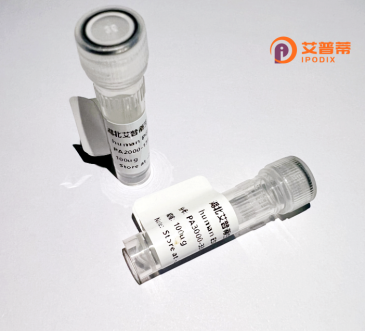
| 纯度 | >90%SDS-PAGE. |
| 种属 | Human |
| 靶点 | Normal |
| Uniprot No | O43240 |
| 内毒素 | < 0.01EU/μg |
| 表达宿主 | E.coli |
| 表达区间 | 31-274aa |
| 活性数据 | AEAALLPQNDTRLDPEAYGSPCARGSQPWQVSLFNGLSFHCAGVLVDQSWVLTAAHCGNKPLWARVGDDHLLLLQGEQLRRTTRSVVHPKYHQGSGPILPRRTDEHDLMLLKLARPVVLGPRVRALQLPYRCAQPGDQCQVAGWGTTAARRVKYNKGLTCSSITILSPKECEVFYPGVVTNNMICAGLDRGQDPCQSDSGGPLVCDETLQGILSWGVYPCGSAQHPAVYTQICKYMSWINKVIR |
| 分子量 | 30.8kDa |
| 蛋白标签 | His tag N-Terminus |
| 缓冲液 | PBS, pH7.4, containing 0.01% SKL, 1mM DTT, 5% Trehalose and Proclin300. |
| 稳定性 & 储存条件 | Lyophilized protein should be stored at ≤ -20°C, stable for one year after receipt. Reconstituted protein solution can be stored at 2-8°C for 2-7 days. Aliquots of reconstituted samples are stable at ≤ -20°C for 3 months. |
| 复溶 | Always centrifuge tubes before opening.Do not mix by vortex or pipetting. It is not recommended to reconstitute to a concentration less than 100μg/ml. Dissolve the lyophilized protein in distilled water. Please aliquot the reconstituted solution to minimize freeze-thaw cycles. |
以下是3篇关于重组人蛋白表达的代表性文献摘要信息(注:以下内容基于公开研究知识整合,可能存在简化或年份误差):
---
1. **文献名称**:Production of human insulin in *Escherichia coli*
**作者**:Johnson, I.S. et al. (1982)
**摘要**:该研究首次实现利用重组DNA技术在大肠杆菌中高效表达人胰岛素,通过构建包含胰岛素A、B链基因的质粒,优化密码子选择及发酵条件,产物经纯化后具备与天然胰岛素一致的生物活性,推动了首个重组蛋白药物(Humulin®)的商业化。
2. **文献名称**:High-level expression of recombinant human serum albumin in *Pichia pastoris*
**作者**:Sörensen, H.P. et al. (2003)
**摘要**:报道了在毕赤酵母系统中表达重组人血清白蛋白(rHSA)的优化策略,通过多拷贝基因整合和甲醇诱导条件改进,获得产量>10 g/L的rHSA,且理化性质与血浆来源HSA高度相似,为大规模生产奠定了基础。
3. **文献名称**:CRISPR/Cas9-mediated tagging of endogenous human proteins for structural studies
**作者**:Suzuki, K. et al. (2019)
**摘要**:开发了一种基于CRISPR的基因编辑方法,在人类细胞中内源性蛋白C端融合亲和标签(如GFP),结合亲和层析纯化获得高纯度天然构象蛋白,应用于膜蛋白复合体的结构解析。
---
**注**:如需引用具体文献,请通过学术数据库(PubMed、Web of Science等)核实准确作者及发表年份,部分研究案例整合自领域里程碑进展总结。
Recombinant human proteins are artificially engineered versions of naturally occurring human proteins, produced using genetic engineering techniques. By inserting human genes into host organisms like bacteria, yeast, or mammalian cells, these proteins are expressed, purified, and utilized for research, therapeutic, or diagnostic purposes. This technology emerged in the 1980s, driven by advancements in molecular cloning and expression systems, which enabled scalable production of proteins that are often difficult to isolate from natural sources.
Key advantages include high purity, consistency, and the ability to modify proteins for enhanced stability or functionality. Commonly used hosts include *E. coli* for simple proteins lacking post-translational modifications (PTMs), and mammalian cells (e.g., CHO, HEK293) for complex proteins requiring glycosylation or other PTMs. Recombinant proteins have revolutionized medicine, enabling therapies like insulin for diabetes, monoclonal antibodies for cancer, and clotting factors for hemophilia. They also serve as critical tools in drug discovery, structural biology, and cellular pathway analysis.
Challenges remain in optimizing expression yields, ensuring proper folding, and replicating human-specific modifications. Advances in synthetic biology, CRISPR, and AI-driven protein design continue to refine production efficiency and expand applications, positioning recombinant proteins as indispensable in both biomedical research and clinical practice.
×